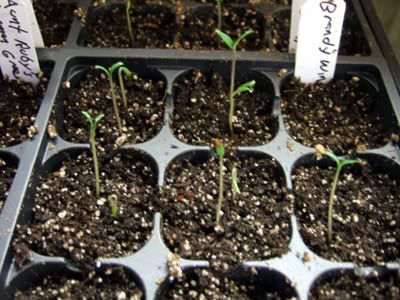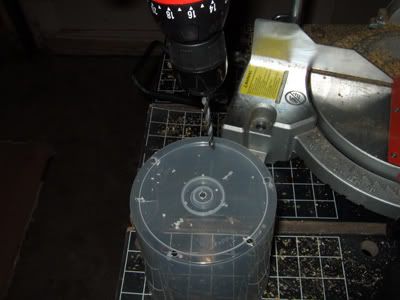Don't be afraid to start vegetable seeds indoors

I am constantly amazed and dismayed by how many people tell me that they couldn't possibly start vegetable plants from seed indoors. I am especially surprised when the person with that thought is an experienced gardener. I am not here to debate or to put down those who don't start veggies from seed. I just want to write a bit for anyone who thinks it is a good idea to start seeds, but is afraid to try.
Don't be intimidated because it's easier than you think. I know there is much written about all the things you need to start seeds and it may seem like a detailed science. I also know it sounds very expensive when people write that you need to have a $200 light stand with $20 grow light bulbs and heating mats and a self waterer and a timer and a soil block maker or massive amounts of peat pots and special trays and special soil and... and... and... Don't let them get you down! All of those things are nice, but most are not necessary. I've been successfully growing vegetable and flower seedlings for years, many times on the cheap!
So what do you really need? Before I answer that question, lets ask another: Is it too late to start indoor seedlings for this season?
NO. It is not too late for most vegetables. On my post about growing extra-early tomatoes, I got some comments from gardeners that they might have waited too long to start their tomatoes. For the record, I just started my main season tomatoes. The picture above shows how big they are today - just sprouts.
The question of when to plant your seeds varies with where on earth your garden is located. Heat loving vegetables like tomatoes, peppers, cucumbers and melons should not be put outside until all danger of frost has passed in your area. I'm sure you've read that on the seed packets before. If you don't know when your average last frost is, you can call your county's cooperative extension service. But if you are reading this post, then you are an internet person and would probably prefer to find out online. There are conflicting reports of dates from one site to another, so be sure to check a few different resources. You can see the "frost free dates for US cities" table that I found to be the most accurate based on the few cities around me at growquest.com or naturalgardening.com.
Once you've determined your last frost date, you should plant your seeds 4-6 weeks earlier, depending on the variety of vegetable you are wanting to grow. That information is usually on the seed packets as well.
Okay, now back to my first question, "so what do you really need for seed starting". The seeds don't know or care how much money you've spent to get their life started. To germinate, they simply need light, a container with soil to root in, water and warmth. There are many ways to adequately provide these things for your plants. I am not pretending to be an expert and I don't want to tell you how to do things, so I will outline what works for me:

Then What?
After your seeds germinate keep them close to the lights. Keep the lights on for 12 to 16 hours per day. I keep the lights on when I am awake. I turn them on first thing in the morning, say hello to my baby plants, water them if they need it and adjust the lights. Just before I go to bed, I check on them and turn the lights off. I used to use a timer to accomplish this, but I would sometimes neglect the watering or light adjusting. Visiting the light stand twice a day is much better.
I transplant most of my seedlings to larger pots when they get their 2nd set of true leaves. You don't necessarily have to transplant. If you choose not to transplant, as the plants get larger, they will run out of nutrients in the small pots. You will need to add liquid fertilizer or compost tea to the trays in order to keep the plants healthy.
About a week before planting your new vegetable starts in the garden, begin getting them used to being outside. Put them outside for an hour or two the first day to experience the wind. The next day keep them out a bit longer. The next day, put them in the direct sunlight. If the night temperature is mild after a few days, keep them out overnight. This gradual process is called "hardening off". It is important to keep the plants from getting diseased, but don't worry too much about it. It is not an exact science. Some years when I didn't have time to fuss with them as much, I just moved the plants to the garage for a couple days before putting them out. If you are worried about this process, be conservative and only harden off half of your plants at a time.
Since it took me so long to explain all of this, I hope I didn't make seed starting seem complicated. It is really pretty simple. There is a lot of information available out there on the subject. If you want to read what some other bloggers have said about seed starting, Carol at May Dreams Gardens asked some seed related questions and compiled a list of bloggers who answered them.
I hope you decide to try starting your own vegetable seeds. There are many benefits to doing so - but that is material for another post.
Happy Seed Starting!














6 comments:
Yes, great gardening minds think alike. Funny that we both wrote about seeds and referenced that same blog post where I listed all the "seedy" gardener posts!
Creative way to recycle those CD spools! I like to use 8oz yogurt containers to start my seeds. I start gathering them from family in January, and feel pretty good about reusing the #5 plastics that would otherwise be thrown in the trash.
Good point Anna. I didn't think about the recycling benefit. Yogurt cups are good to use. I also use my kids pudding cups that are about the same size. Individual 16 0r 20 ounce pop bottles are also good, and half gallon milk cartons for bigger containers. And don't forget to save popsicle sticks to use as plant markers!
Anything that can be recycled and pressed into service for the garden is a good thing in my book.
Marc, thanks for the advice about light. I do have a grow light in the basement, but didn't want to take it down and move it to the greenhouse. There is sun today, so the seedlings are happy.
You have a great blog, I will add you to my friends list, so I will remember to check back.
Happy Spring!!
Thanks for the kind words - vonlafin.
You have a great blog too!
This is a really good explanation about seed starting. Thanks for commenting over at In the Garden Online---and I'm with you... I love the smell of tomato seedlings. It's the first real sign of summer, as far as I'm concerned.
I may actually take your advice and start some tomatoes now. I never start them this late, but it's worth a shot, eh?
Post a Comment